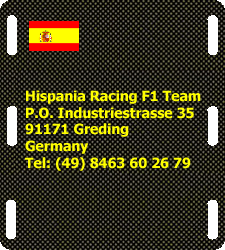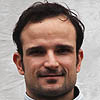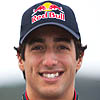|
At the end of the 2008, Adrian Campos, a former F1 driver who had subsequently gone on to enjoy success as boss of his own Nissan Series, F3 and GP2 teams, announced that he was selling his GP2 team, but would remain involved in F3.
He also talked of another project but refused to give details.
Having previously been linked with a possible buy-out of the Super Aguri F1 team in early 2008 it came as no surprise when Campos appeared on the list of hopefuls to be considered by the FIA for inclusion in the 2010 world championship.
However, with Prodrive and Lola turned down there were more than a few raised eyebrows when on June 12 the FIA revealed the identities of the four new teams, one of them having only come into existence a couple of months earlier when Campos and Enrique Rodriguez, president of Meta Image a Madrid-based sports agency, first started analyzing the idea.
By April 2009, still to have their entry accepted, Campos Meta 1 - as the team was now known - signed an agreement with Italian race car manufacturer Dallara for the design, development and construction of the team's cars at its Parma HQ.
Dallara, which has enjoyed success in all manner of other disciplines - usually building cars for other constructors such as the Ferrari 333SP, the Lancia LC1 Group 6 and Audi R8 - contested the Formula One World Championship between 1988 and 1992, its best season being 1989 when it scored 8 points.
In September 2009 the team agreed a deal with the regional government in Murcia to build a Technological Park in Fuenta Alamo, which Campos was to describe as his team's "own Maranello".
A month later, the team was one of the first new entries to name one of its drivers the Spanish outfit opting for Bruno Senna nephew of the legendary three-time world champion.
Over the winter the car passed the first of its various safety tests as attention drifted as to who might partner Senna in the team's first season.
However, in early January, following comments made by Bernie Ecclestone that one or two of the new teams might not make it to the grid, speculation began to mount that Campos Meta was one of those teams, US F1 being the other.
Among the names being linked with the Spanish team was A1 GP's Tony Teixeira who, according to some, had been looking to get into F1 for some time. Then again, with the collapse of A1 GP the Portuguese-South African certainly has time on his hands, that's if talk of a link with (Renault buyer) Genii Capital is not to be believed.
Reacting to the speculation, Campos said: "People speak too much and make trouble for us. We are talking with people who would like to be shareholders. We are looking for investors and sponsors but the project is very much alive.
"I don't want to sell my part of the team and I will remain the team principal," he added, "the condition to be a shareholder is to accept all the existing contracts.
"We expect to have more investors," Campos continued. "People speak about Teixeira, but we are talking to others as well."
Meanwhile, Dallara dismissed claims that Campos had fallen behind in its payments.
"It is not true, not from our side at least," said the Italian constructor's chief executive officer Andrea Pontremoli. "We are still proceeding to build the car and it has passed its crash tests."
The weeks passed, and with no news from the team, the speculation increased. Teixeira continued to be linked with the Spanish outfit even though he had his own problems what with what was left of A1 GP finally being put in the hands of administrators.
US F1 also had its own problems, and with both teams looking doubtful for the opening race, if not the season, Serbian hopeful Stefan GP moved out of the wings and into centre stage. Set up by Serbia businessman Zoran Stefanovic, the team had done a deal with Toyota which meant that it had the cars the Cologne-based outfit was working on when its parent company had pulled the plug in late 2009.
As the countdown to the season opener continued the speculation and rumours grew ever more bizarre. There was talk of Campos merging with US F1, Campos merging with Stefan GP, in some quarters there was even talk of all three getting together.
Finally, on February 19, former Midland and Spyker team boss, Colin Kolles, announced that a deal had been secured whereby Campos - albeit with a new name - had been saved. Step forward Spanish entrepreneur and businessman Jose Ramon Carabante, who was already a partner in Campos.
While it was goodbye to Campos, it was Ola to Hispania Racing.
A couple of weeks later, as speculation as to whether the new team would make it to the grid in Bahrain continued, Kolles issued another statement, this time confirming the change of name to Hispania Racing - which had rather unfortunately been shortened to HRT F1 - and announcing that the car would be unveiled the following day. A few hours later the FIA issued the definitive entry list for 2010 and while HRT F1 was there in all its glory, US F1 and Stefan GP were conspicuous by their absence.
As promised, the following the day Hispania unveiled its car, together with drivers Bruno Senna and Karun Chandhok.
While the financial arguments between the team and constructors Dallara continued, the Italian manufacturer demanded that its name wasn't present on the car.
On paper, 2010 was an absolute disaster for the Spanish team however, when one considers the whole story to have made it to the grid and finish the season was an achievement in itself for the latecomers.
With no pre-season testing, the car was unveiled on the Friday of the season opening Bahrain Grand Prix, indeed, Bruno Senna only just managed to complete a couple of laps in the opening free session since the car had only just been completed.
In the second practice session Senna completed 17 laps before sliding off the track with a loose wheel, his best time over 11s off the pace. With the second car still incomplete, teammate Karun Chandhok didn't get to drive the car until the qualifying session next day.
Using mechanics from his own sports car and DTM teams together with members of the Campos Meta F3 outfit, Kolles was able to put a half-decent crew together, though none of them had F1 experience.
The car was as basic as one could get away with however, the recruitment of former Honda technical director Geoff Willis three weeks before the start of the season meant that work was already going on behind the scenes.
Willis' criticism of the Dallara was scathing, describing it as years out of out and more akin to a GP2 car. "Maybe they thought this would be a super-duper GP2 car that needed to be thirty percent better," he said. "Forget it, it needed to be ten times better."
Understandably, the first couple of races were tough however, by Malaysia both cars were finishing races, albeit a couple of laps behind the leaders.
Over the course of the season reliability improved, indeed, like most of the new teams it was a Xtrac hydraulics that was the real Achilles heel. However, appreciating that continued financial problems meant that there could be no improvement to be basic package - far less upgrades - the team sought to improve its performance in other ways namely strategy.
The financial restraints affected the driver line-up also, and once Senna was dropped in favour of Sakon Yamamoto for the Silverstone weekend it came as no surprise when Chandhok was dropped for the Japanese driver in Germany. While the Indian never sat in the F110 again (lucky him?), Yamamoto was replaced in three of the last five races by Christian Klien. Interestingly, in Singapore, the first of the races in which Klien replaced Yamamoto, the team clamed the Japanese driver was suffering from food poisoning - though that didn't stop him attending the event on Saturday and Sunday and carrying out PR duties.
All in all, the team did well with what it had, Colin Kolles performing miracles under the circumstances. However, this is Formula One, the so-called pinnacle of motorsport, and such an amateur approach - no matter how well intentioned - was simply not acceptable.
Things looked little better for 2011, especially when Narain Karthikeyan was recruited - a move which no doubt owed more to his financial backers Tata - alongside Tonio Liuzzi, whose seat had already been paid for by Force India which had dumped the Italian in favour of Paul di Resta.
The F111, was launched on the penultimate day of the final pre-season test in Barcelona - what would have been the Friday of the Bahrain GP had it not been cancelled - but didn't run because Spanish customs still hadn't cleared the release of the dampers for the cars. Or so the Spanish team said.
Furthermore, despite the numerous 'Your Name Here' logos - part of the livery designed by Hollywood concept vehicle designer Daniel Simon, best known for his work on the film Tron: Legacy - there was no mistaking the fact that the F111 was very, very similar to its predecessor. Indeed, there is talk that though Hispania no longer had access to the (Dallara designed) TF110, Geoff Willis had been allowed access to the plans long enough to be able to carry many of the ideas over to the F111.
The F111 arrived in Melbourne in pieces, and a superhuman effort by the crew enabled Karthikeyan to take part in the final minutes of the Saturday practice session. However, still lacking 2011-spec nose and front wing - which had not passed the mandatory crash tests - both drivers were over two seconds off the pace in qualifying - and yes, both cars were ready - and therefore failed to qualify having fallen foul of the 107% rule.
Things improved by the time the circus arrived in Malaysia, indeed there were even a few updates, allowing both drivers to qualify, albeit for the back row of the grid.
Much like Virgin - with whom the Spanish team was locked in battle for the entire season - things pretty much continued like this for the remainder of 2011, qualifying no higher than twenty-first and finishing at the back of the field. That said, unlike 2010, the Spanish cars were at least finishing, reliability having vastly improved on the previous season.
As was the case for many teams, the conditions in Canada offered the best chance of a freak result, and while Tonio Liuzzi could only manage thirteenth - the team's best result of 2011 - it was enough to beat Virgin to eleventh position in the Constructors' Championship.
While the team continued to struggle on track, behind the scenes much was going on. In July, Thesan Capital bought a significant stake in the team, Saul Ruiz de Marcos replacing Jose Ramon Carabante and immediately setting about changing its structure, not least the name, Hispania giving way to HRT.
Another move saw the team reach a deal with Red Bull which saw test driver Daniel Ricciardo replace Karthikeyan, the highly rated Australian thus getting his first taste of F1 in a racing environment.
While rivals Virgin agreed a technical collaboration with McLaren, HRT joined forces with Williams, the Grove outfit providing gearboxes and KERS for the Spanish outfit from 2012. Another deal saw the Spanish team given access to one of Mercedes windtunnels.
Having parted ways with Geoff Willis, and failed to recruit Jorg Zander, HRT appointed Jacky Eeckelaert as Technical Director, whilst subsequently dumping Kolles in favour of (former F1 driver) Luis Perez-Sala. With the team having been based at Kolles Cologne HQ, another moves sees HRT set up base in a new purpose built facility in Spain.
As if to fully demonstrate its Spanish credentials, days ahead of the 2011 season finale, HRT confirmed that it had recruited veteran Pedro de la Rosa, the McLaren tester having enjoyed just one outing that season when called to replace Perez in Canada.
The new people behind HRT appear to mean business however, only time will tell if talk can be converted into action and even then one has to wonder whether the Spanish team has the financial backing to take that next big step.
Statistics - at the end of the 2011 Season
Drivers' Titles: 0
Constructors' Titles: 0
Seasons in F1: 2
Grand Prix: 37
Wins: 0
Poles: 0
Fastest Laps: 0
Best result in 2011: 13th (Liuzzi - Canada)
Best qualifying 2011: 21st (6 Times)
Worst qualifying 2011: 24th (10 Times)
2011: Karthikeyan out-qualified Liuzzi 0 Times
2011: Liuzzi out-qualified Karthikeyan 7 Times
2011: Ricciardo out-qualified Liuzzi 4 Times
2011: Liuzzi out-qualified Ricciardo 6 Times
2011: Ricciardo out-qualified Karthikeyan 1 Time
2011: Karthikeyan out-qualified Ricciardo 0 Times
2011: Completed: 1847 out of 2150 laps (85.9%)
2011: Finished 27 times from 36 starts (75%)
|


























